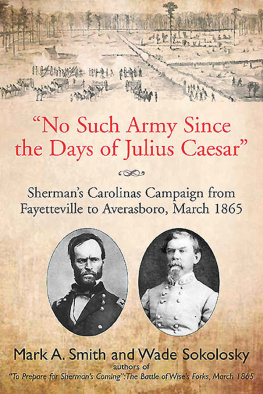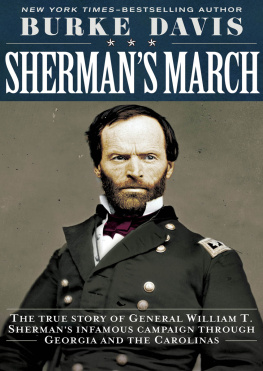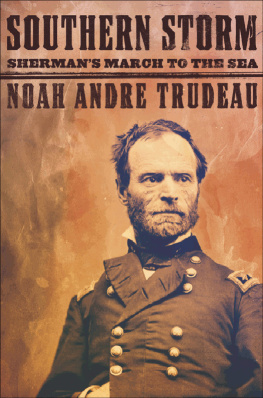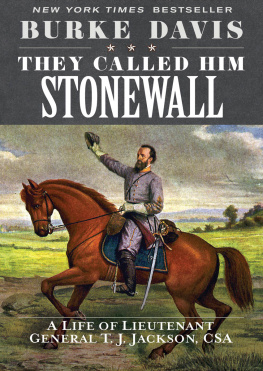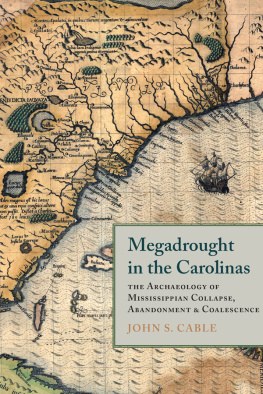Shermans March Through the Carolinas
1956 The University of North Carolina Press
All rights reserved
Manufactured in the United States of America
ISBN 0-8078-0701-X (cloth : alk. paper)
ISBN 0-8078-4566-3 (pbk. : alk. paper)
Library of Congress Catalog Card Number 56-14242
07 06 05 04 03 14 13 12 11 10
THIS BOOK WAS DIGITALLY PRINTED.
To my wife, LUTE and
my mother, Miss Ruby
PREFACE
GENERAL WILLIAM TECUMSEH SHERMAN always maintained that the Carolinas campaign of 1865 was his greatest military achievement. Writing after the war he said: No one ever has and may not agree with me as to the very great importance of the march north from Savannah. The march to the sea seems to have captured everybody, whereas it was childs play compared with the other. The Georgia campaign, as Sherman suspected, has through the years caught the interest of both the public and the historian. The story of this march has been often and well told. Little has been written of Shermans important operations in North and South Carolina. This omission has left incomplete the story of the end of the war on the Eastern front. The author has attempted both to correct the omission and to assess the validity of Shermans personal judgment.
This book was prepared under the immediate direction of Professor Fletcher M. Green, head of the history department of the University of North Carolina. Without his advice, encouragement, and understanding this volume would not have been possible.
Sincere thanks are also due to Professors Hugh T. Lefler and James W. Patton of the University of North Carolina, and Richard E. Welch, Jr. of the Virginia Military Institute. These three historians read the manuscript in its entirety and made invaluable criticisms.
In addition I am indebted to The University of North Carolina Press, to Mrs. John B. Graham, my sister, and to Mrs. Marion Smith of Chapel Hill, North Carolina, whose careful examination of the manuscript prevented many literary errors.
Special thanks go to Mr. Jay Luvaas of Duke University who made available to me much valuable material on the battle of Bentonville.
The staffs of the Southern Historical Collection of the University of North Carolina, the Manuscript Division of Duke University Library, the North Carolina Department of Archives and History, the South Caroliniana Collection of the University of South Carolina, the Manuscript Division of the Library of Congress, and the Library of the Virginia Military Institute have all been most helpful.
Finally and especially I wish to express appreciation to my wife, Lute Buie Barrett, who not only listened and encouraged but spent many long and tiring hours at a typewriter.
Lexington, Virginia
May 1, 1956
CONTENTS
THE FOLLOWING ABBREVIATIONS HAVE BEEN USED IN THE FOOTNOTES
AHRAmerican Historical Review
B and LBattles and Leaders of the Civil War
Hist. Mag.The Historical Magazine and Notes and Queries concerning the Antiques, History and Biography of America
JSHJournal of Southern History
L.C. Library of Congress
M.R.The Medical and Surgical History of the War of Rebellion, 1861-1865
M.V.H.RMississippi Valley Historical Review
Mag. of Amer. Hist.Magazine of American History, with Notes and Queries
Mass. Mil. PapersPapers Read Before the Military Historical Society of Massachusetts
Mil. Order of the Loyal Legion, CommanderyWar Papers Read Before the Commandery of the State of, Military Order of the Loyal Legion of the United States
N.R.Official Records of the Union and Confederate Navies in the War of Rebellion
NCC North Carolina Collection
NCHRNorth Carolina Historical Review
ORThe War of Rebellion: A Compilation of the Official Records of the Union and Confederate Armies
VQRThe Virginia Quarterly Review
SCL South Caroliniana Library
SHC Southern Historical Collection
Shermans March Through the Carolinas
CHAPTER I
Tent Pins Under A Magnolia
WILLIAM TECUMSEH SHERMAN, third son and sixth child of Charles and Mary Sherman, was born February 8, 1820, in Lancaster, Ohio. The sudden death of Judge Charles Sherman of the state supreme court in 1829 left his wife with a meager income and eleven children to rear. There was no other recourse for her but to distribute some of the children among relatives, neighbors, and friends. Hence, young Cump, as he had been nicknamed by his brothers and sisters who could not pronounce Tecumseh, went to live in the home of his fathers close friend and neighbor, Thomas Ewing. The wealthy Ewing was more than glad to welcome the redheaded youngster into his family. He owed much to Cumps father, who had helped him get a start as a frontier lawyer.
Sherman, in turn, became indebted to his foster father for his early education and appointment to the United States Military Academy in 1836. West Point, aristocratic in manner, ideals, and religion, was an institution in which Southern ideals primarily held sway. The youth of the South, with their polished manners and easy confidence, had enrolled in proportionately larger numbers than the young men of the North and West. Thus Sherman in his sixteenth year came under the influence of an army which had from the first been largely under Southern influence.
Cump Shermans record at West Point was not exceptional. In later years he wrote: I was not considered a good soldier. I was not a Sunday-school cadet. I ranked 124 in the whole student body for good behavior. My average demerits, per annum, were about 150, which reduced my final class standing from Number 4 to Number 6. He was never one to place much emphasis on tidiness of dress. Unshined shoes, tarnished buttons, and soiled clothing accounted for many demerits. His yearly average of 150 black marks was perilously close to the 200 mark which meant dismissal from the Academy.
At West Point Shermans closest friends were Stewart Van Vliet of Vermont and George Henry Thomas of Virginia. The latter he called his best friend a high-toned, brave, and peculiar Virginia gentleman. The class rolls carried the names of many Southerners who were to win fame on the field of battle. Braxton Bragg, Pierre Gustave Toutant Beauregard, and Jubal Early fought gallantly for the South, whereas Edward Otho Cresap Ord, Edward Richard Sprigg Canby, and Don Carlos Buell, along with Thomas, cast their lot with the North.
After graduation in 1840 Lieutenant Shermans first assignment was with the Third Artillery at Fort Pierce, Florida. This duty lasted eighteen months, after whch he was transferred to Fort Moultrie on Sullivans Island in Charleston harbor. Here he remained for four years. During this period Sherman traveled extensively through the South. He became acquainted with the people and the problems of the region. What he saw appealed to him. The young officer not only learned about the South but learned to like it. For the first time he came in direct contact with slavery, an institution he was soon to accept almost without reservation.
While stationed in Florida and South Carolina, Sherman actively participated in and enjoyed social life. In the South, where army life had a strong appeal, the bright button was a passport at all times to the houses of the best. On the other hand, the sporadic war waged against the Seminole Indians of Florida was boring to the young Lieutenant for he had the opportunity to fire only a few shots at the wily adversary. But the gay social life at St. Augustine more than compensated for the long hours of garrison duty.



